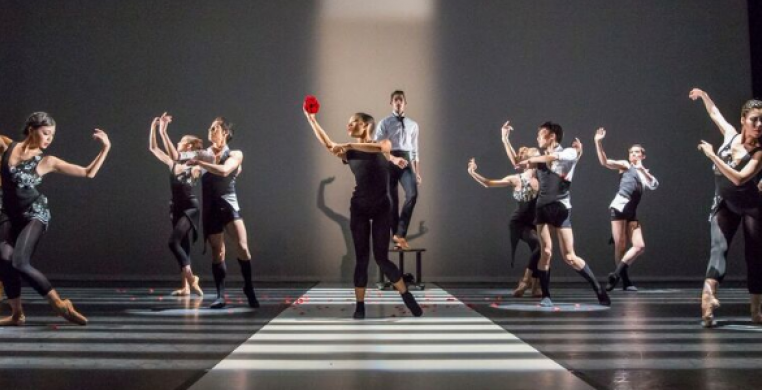For six years, the Joffrey Academy has presented “Winning Works,” featuring Joffrey’s studio company and dancers from the Joffrey Academy’s Trainee program performing works by winners of Joffrey’s annual choreography competition. The engagement has sold out three performances at the Museum of Contemporary Art’s Edlis Neeson Theater for the past few years, with 2016’s version touting stellar choreography, sensational young talent, and top notch production value.
The Winning Works Choreographic Competition was created to recognize talented and emerging ALAANA (African, Latino, Asian, Arab and Native American) choreographers and to provide them with a platform to showcase their original and innovative work. The winning choreographers are awarded a $5,000 stipend and provided the opportunity to work under the artistic supervision of Joffrey Academy Artistic Directors Anna Reznik and Alexei Kremnev. This year, three emerging choreographers, Christian Denice, Jeffrey Cirio, and Mariana Oliveira, spent approximately two weeks with the dancers, each on the cusp of professional careers as performing artists. The energy in the theater at a Winning Works performance is contagiously optimistic; for these young dancers, it’s a coming of age moment as they transition from student to professional. To make that transition in the presence of great choreographers is exciting, to say the least, and last weekend at the MCA will likely remain one of these dancers’ most memorable moments.
Jeffrey Circio’s “Chapter 1, chapter 6” and Christian Denice’s “Urgence” share a contemporary aesthetic, with low, sliding centers of gravity maximized through creative sock dancing. While this is not surprising from Denice, whose lineage includes River North Dance Chicago and Les Ballets Jazz de Montreal, Circio’s silky, club-inspired movements are a departure from his background at Boston Ballet and American Ballet Theatre.
“Chapter 1, chapter 6” features dancer Tess Voelker, whose waif-like figure also dominates Oliveira’s “Death and the Maiden.” The women, dressed as contemporary wilis in Gabriel Brandon-Hanson’s long-sleeved white leotards and veils, are straddling life and death, tempted by the men to "come to the dark side,” so to speak. Stunning ink blot projections are like morphing Rorschach tests, put to best use when the dancers are upstage with their shadows. Though Oliveira’s vocabulary is closer to ballet than her counterparts, she doesn’t make it easy on these young classicists. The partnering is hard, as is her treatment of Franz Schubert’s string quartet sharing her dance's title.
Denice’s “Urgence” is a comment on the strength of communities and individuals in times of crisis. Specifically referencing the droughts in southern California, the designs’ orange and red tones allude to dry, cracked earth. Jason Brown’s lighting choices manage to compliment the awkward orange pants and dance dresses, as does strong choreographic direction from Christian Denice. In a video introduction to the piece, Denice speaks about how exciting it is to work with dancers at a point in their careers when they are just figuring out what to do with their technique, and how to convey emotion and intent through technical dancing.
Not to be overlooked is the fourth dance on the program, a group work from Joffrey Academy Director Alexei Kremnev. His “Coco & Igor” is a full-length ballet smooshed into 15 minutes. The lines between fiction and non-fiction are blurred concerning the relationship between Coco Chanel and Igor Stravinsky, whose respective crafts influenced each other. Sophisticated black and white costumes and Jason Brown’s pinstriped gobo illuminating the floor give a classy air that matches the characters inspiring the work. A vertical stripe of white marley divides the stage into halves; with Stravinsky on one side and Chanel on the other I’d go so far as to draw parallels to the Sharks and the Jets, dividing Eastern and Western sentimentalities in a sort of forbidden affection complemented by Stravinsky’s tribal “Rite of Spring” as the score.
With the performances done, costumes headed up to storage, and young dancers off to seek their paths for the future, I’m left wondering: what exactly happens to these works once Winning Works is through? Each of the dances on the program merits continuation, but regretfully, there doesn’t appear to be an initiative in place to pass these works to the main company, or somewhere else entirely.

